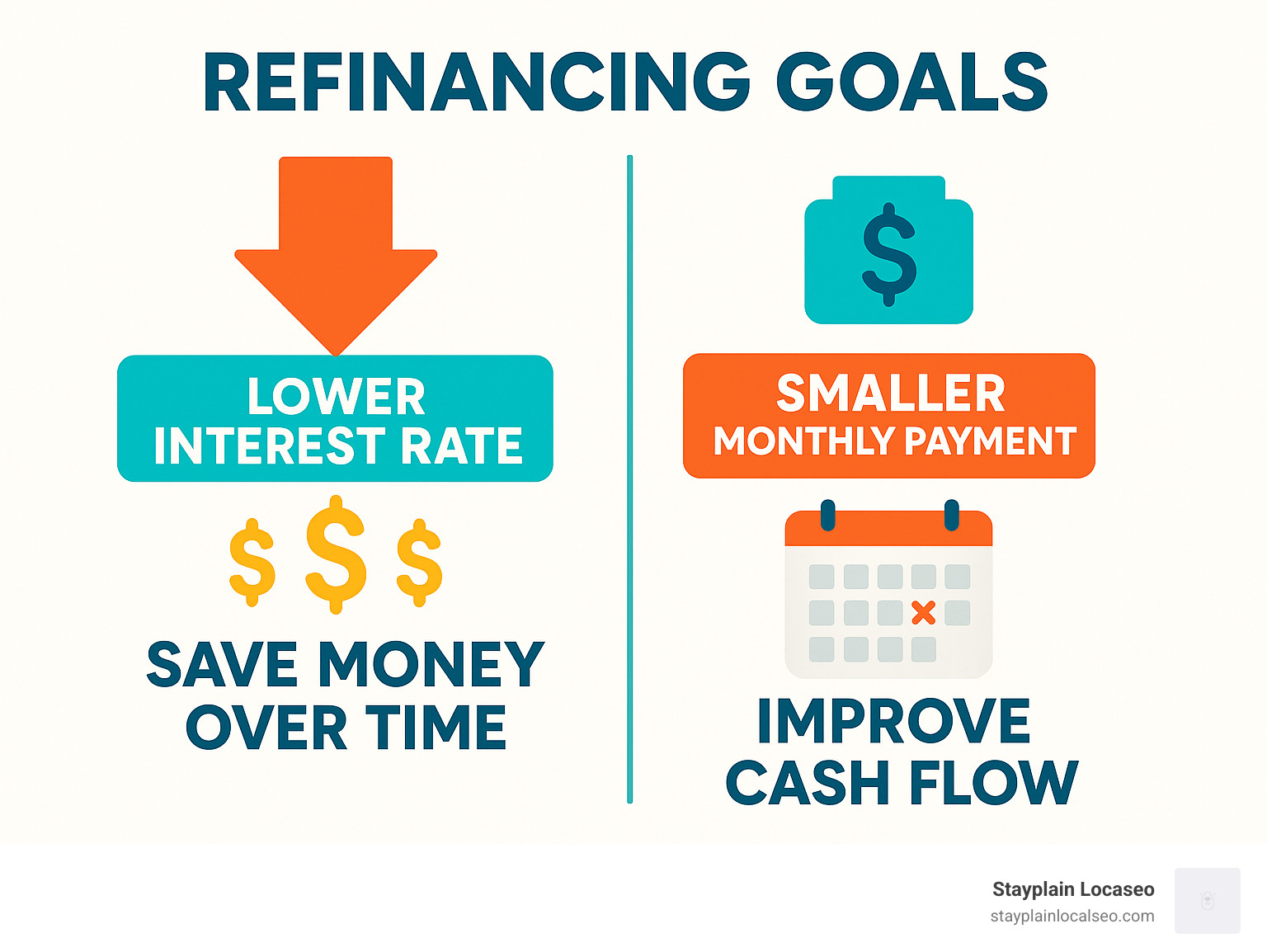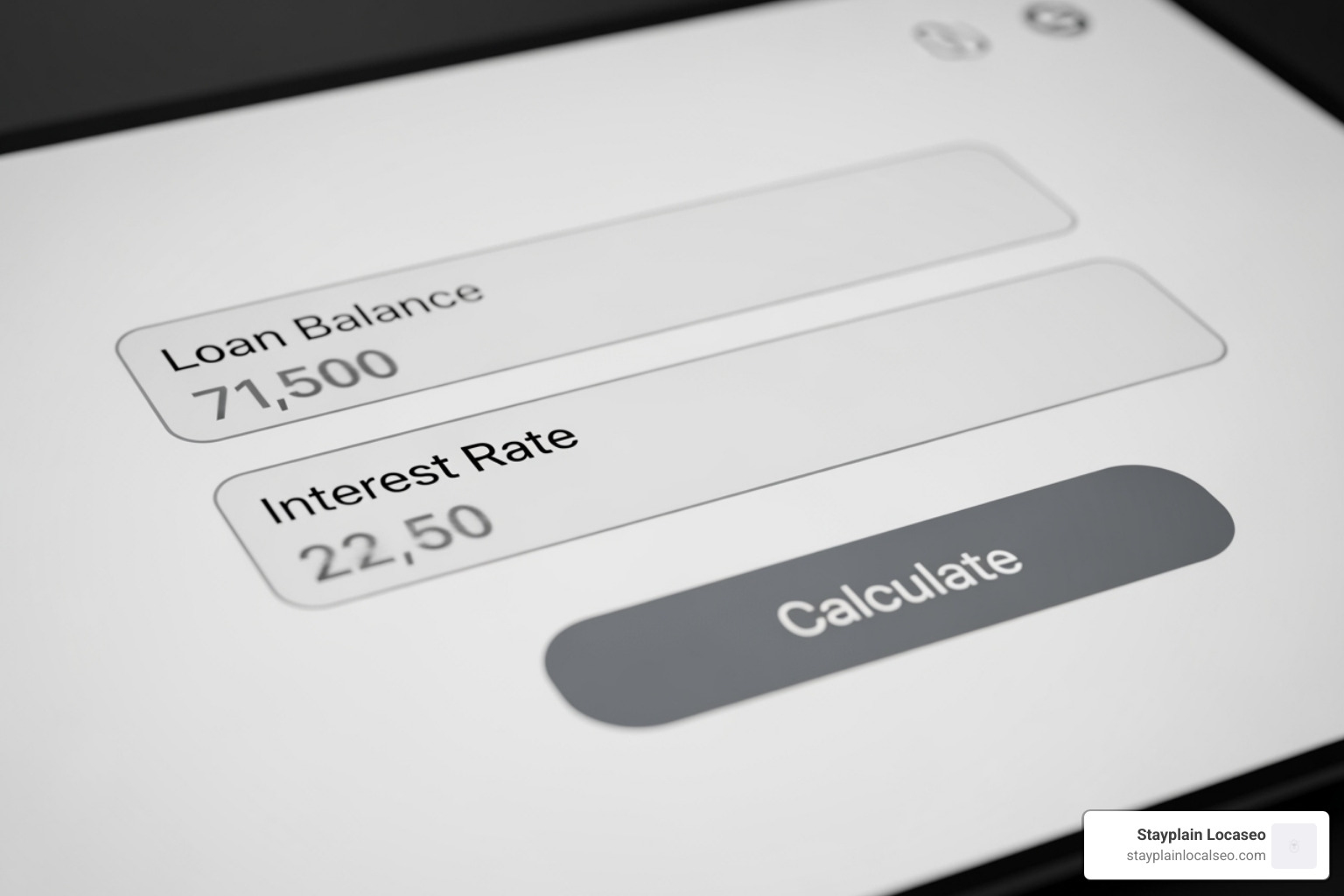
Why a Student Loan Refinance Savings Calculator is Your First Step to Financial Freedom
A student loan refinance savings calculator is a free online tool that shows how much you could save by refinancing your student loans. By entering your current loan details, it instantly calculates your potential new monthly payment and total interest savings.
Quick Answer: What You Need to Know
- Current loan balance – Total amount you still owe
- Current interest rate – Your existing rate (or weighted average)
- Remaining loan term – Years left to pay off your loans
- New estimated rate – The rate you might qualify for
- Results show – New monthly payment, monthly savings, and total interest saved
With massive student debt affecting millions of Americans, reducing this burden is critical. Student loan refinancing replaces your existing loans with a new private loan, ideally with better terms like a lower interest rate.
The potential savings can be substantial. Refinancing your student loans could save you thousands of dollars in interest over the life of your loan. Many borrowers save tens of thousands by securing rates under 5%, especially if their current rates are above 6%.
However, refinancing isn’t for everyone. The decision depends on your finances, loan types, and whether you need federal loan protections. This is where a savings calculator becomes invaluable. It allows you to see the numbers before committing, showing different scenarios like choosing a shorter term to pay off debt faster or a longer term to lower your monthly payment.
Best of all, using a calculator is free and doesn’t impact your credit score. It’s a no-risk way to explore your options and see if refinancing makes sense for you.

Terms related to student loan refinance savings calculator:
- how to refinance student loans step by step
- minimum credit score to refinance student loans
- refinance student loans no degree
Understanding the Student Loan Refinance Savings Calculator
A student loan refinance savings calculator takes the guesswork out of one of your most important financial decisions. It’s a tool for debt management that lets you plug in your current loan information, experiment with different scenarios, and instantly see how refinancing could impact your finances. The calculator crunches complex numbers in seconds, showing potential monthly savings and total interest reductions.
These calculators are powerful because they help you visualize the trade-offs. If you want to lower your monthly payment to free up cash, the calculator shows how extending your repayment term affects your budget. If you’d rather pay off debt faster and save on total interest, you can see how a shorter term with a lower rate accelerates your path to financial freedom.
The beauty lies in the comparison. You might find that refinancing from a 7% to a 4% rate could save you $15,000 over ten years. Or you might learn that dropping your monthly payment by $200 gives you needed breathing room, even if it means paying more interest long-term.

What Information Do You Need for a Student Loan Refinance Savings Calculator?
To get accurate results from a student loan refinance savings calculator, you need the right inputs. Close estimates work fine for initial calculations.
Your current loan balance is the foundation. If you have multiple loans, add up all the outstanding balances to get your starting point.
Next, you’ll need your current interest rate. If you have multiple loans, many calculators ask for a weighted average interest rate. This means your rates are calculated based on how much you owe on each loan, giving a more accurate picture.
Your remaining loan term completes the picture. If you started with a 10-year plan three years ago, you have seven years left. This helps the calculator compare your current timeline to new terms.
The calculator typically provides estimated ranges for new rates and terms, letting you play with different scenarios. Your actual rate will depend on your credit score and income, but these estimates provide a solid starting point.
How to Find Your Current Loan Details
Tracking down your loan details is easier than you think. The key is knowing where to look.
Federal loans are the easiest. Your one-stop shop is StudentAid.gov, where you can access the National Student Loan Data System. This government portal shows every federal loan you’ve received, with balances, rates, and servicer information.
Private loans require a bit more sleuthing. Your credit report is your best friend here, as it lists all open accounts, including private student loans. You can pull your report for free once a year from each major bureau at AnnualCreditReport.com.
Alternatively, check your recent loan statements or log into your servicer’s online portal for the most up-to-date information. A quick call to your loan servicer can also fill in any gaps.
The Pros and Cons of Refinancing
When considering refinancing your student loans, it’s important to weigh the potential savings against the significant trade-offs. The key to a smart decision is understanding exactly what you’re gaining and what you might be giving up. Let’s walk through both sides so you can make the right choice for your situation.

Key Benefits of Refinancing Your Loans
The benefits of refinancing can be life-changing, especially if you’re dealing with high-interest loans.
Lower interest rates are the biggest draw. If your credit has improved or market rates have dropped, you could qualify for a much better rate. Refinancing from 7% down to 4%, for example, could put thousands of dollars back in your pocket. A student loan refinance savings calculator can show you just how much you could save.
Lower monthly payments can provide immediate budget relief. By extending your repayment term (e.g., from 10 to 15 years), you can cut your monthly payment, freeing up cash for other goals like building an emergency fund.
Conversely, refinancing can help you pay off your debt faster. By securing a lower interest rate and choosing a shorter term, more of each payment goes toward your principal. Your monthly payments might be higher, but you’ll be debt-free years sooner.
Loan simplification is another huge, often overlooked advantage. Refinancing can roll multiple loans with different servicers and due dates into one monthly payment.
You can also choose between fixed and variable rates. Fixed rates offer predictable payments, while variable rates might start lower but can change. Most people prefer the stability of a fixed rate.
For a deeper dive, see our guide on how to refinance student loans step by step.
Critical Considerations Before You Refinance
While refinancing offers great benefits, it’s not without risks, especially if you have federal student loans.
The biggest consideration is the loss of federal protections. When you refinance federal loans with a private lender, they become private loans forever. This decision is irreversible and means losing access to valuable safety nets.
| Feature | Federal Student Loans | Refinanced Private Loans |
|---|---|---|
| Income-Driven Repayment (IDR) | Payments based on your income, potentially as low as $0 | Fixed payments regardless of income changes |
| Public Service Loan Forgiveness (PSLF) | Complete forgiveness after 10 years of qualifying payments | Not available |
| Deferment and Forbearance | Multiple options to pause payments during hardship | Very limited options, varies by lender |
| Federal Forgiveness Programs | Various programs for teachers, healthcare workers, etc. | None available |
If you work in public service or might need income-driven repayment options, refinancing federal loans could be a costly mistake. Once these protections are gone, they’re gone for good.
There’s also the hard credit inquiry. Applying for refinancing causes a small, temporary dip in your credit score. This is minor but worth considering if you’re about to apply for a mortgage or car loan.
Finally, eligibility matters. Lenders look for a good credit score (mid-600s or higher), stable income, and a reasonable debt-to-income ratio. Our guide on the minimum credit score to refinance student loans can help you understand what lenders want.
Refinancing can be a great tool, but it’s not a decision to take lightly. Run the numbers and understand what you’re gaining and giving up.
A Step-by-Step Guide to Calculating Savings and Applying
Now let’s cover how to use a student loan refinance savings calculator and steer the application process. This roadmap can guide you to potentially saving thousands.

Step 1: Assess Your Financial Health
Before using a calculator, evaluate your financial standing. Your credit score is crucial; lenders use it to determine your eligibility and interest rate. A score in the 700s will likely get you the best rates. You can often check your score for free through your bank or credit card company.
Next is your debt-to-income (DTI) ratio, which compares your monthly debt payments to your gross monthly income. Lenders prefer a DTI below 50%. A lower DTI signals that you can comfortably handle loan payments.
Stable income and employment are also key. Lenders want to see consistent paychecks. If your financial picture isn’t ideal, consider improving it before applying. Sometimes waiting to build credit or increase your income through opportunities like Live Chat Jobs is the best first move.
Step 2: Use a Student Loan Refinance Savings Calculator to See Your Options
With your financial details in hand, it’s time to use a student loan refinance savings calculator. You can use our calculator here.
Plug in your current loan balance, interest rate, and remaining term. Then, experiment with different potential new rates and terms to see how they affect your payments and savings.
When interpreting the results, look beyond just the new monthly payment. Understanding monthly savings versus lifetime savings is crucial. A longer 20-year term might lower your monthly payment, but you’ll likely pay more in total interest. A shorter 5- or 7-year term means higher monthly payments but can lead to massive interest savings and getting out of debt much sooner.
For example, refinancing a $100,000 loan from 6% to 5% over 10 years could save nearly $20,000 over the full term. Shorten that to 5 years at 4%, and you could save over $22,000. The calculator makes these trade-offs clear, helping you decide between immediate cash flow relief and maximum lifetime savings.
Step 3: Compare Lenders and Get Pre-qualified Rates
Once you know your potential savings, it’s time to shop around for a lender. This step is essential, as different lenders offer different terms.
The prequalification process is your best tool here. Many lenders provide realistic rate estimates with a “soft pull” on your credit, which does not affect your credit score. This allows you to collect and compare actual offers side-by-side.
When comparing offers, focus on the Annual Percentage Rate (APR), which includes the interest rate plus any fees, giving you the true cost of borrowing. Also, confirm that there are no origination, application, or prepayment fees.
Consider repayment options and customer service, as these can be important down the road. While optimizing your finances, you might also explore wealth-building opportunities. Learning about Total Money Magnetism – New Huge Converter or mastering Precision Trading Academy: Master Securities Trading can complement your debt optimization efforts.
After choosing the best offer, you’ll submit a formal application. This involves a “hard pull” on your credit and providing documents like pay stubs and loan statements. Most lenders make decisions within a few days. For more details, see our guide on how to refinance student loans step by step.
Frequently Asked Questions about Refinancing
When you’re exploring refinancing with a student loan refinance savings calculator, questions are bound to come up. Here are answers to the most common concerns.
How often can you refinance your student loans?
There is no legal limit to how many times you can refinance your student loans. If a better deal comes along because your credit score has improved or market rates have dropped, you can refinance again. Since most reputable lenders don’t charge application or prepayment fees, refinancing again won’t cost you anything upfront. We’ve seen borrowers refinance multiple times, each time lowering their interest rate.
What should you do if you don’t qualify for refinancing on your own?
Being denied for refinancing isn’t the end of the road. Adding a co-signer with strong credit and stable income is often the fastest path to approval and can lead to much better interest rates. A co-signer is legally responsible for the loan if you can’t make payments.
If a co-signer isn’t an option, focus on strengthening your financial profile. This means paying bills on time to boost your credit score, increasing your income, and paying down other debts. For federal loan holders who don’t qualify, federal programs like income-driven repayment plans might be a better option anyway, as they preserve your federal protections.
For those with unique challenges, our guide on refinancing student loans without a degree offers specialized strategies.
Does refinancing hurt your credit score?
This is a common question with a nuanced answer. When you get prequalified rates, lenders do a “soft credit pull,” which has zero impact on your credit score. This is why we encourage shopping around.
When you formally apply, the lender does a “hard credit pull,” which can cause a small, temporary dip in your score, usually just a few points. This dip typically recovers within a few months.
Over time, refinancing can actually improve your credit score. A lower, more manageable payment makes it easier to pay on time, and payment history is the biggest factor in your score. A lower payment also improves your debt-to-income ratio, which credit bureaus view favorably.
For those looking to improve their overall financial wellness, exploring opportunities like building wealth through manifestation techniques or developing multiple income streams can complement your debt reduction strategy. The small, temporary credit score dip is usually far outweighed by the long-term benefits of a more affordable loan.
Take Control of Your Student Debt
Managing student loan debt can feel overwhelming, but with the right tools, you can create a strategic plan for your financial future. The student loan refinance savings calculator is your most powerful first step. It provides the clarity needed to make confident decisions, whether you want to lower monthly payments or become debt-free faster.
We’ve covered how these calculators work, the compelling benefits of refinancing—like lower rates and simplified payments—and the critical trade-offs, such as the loss of federal loan protections. This is a major decision that requires careful consideration of your career, income, and risk tolerance.
Our step-by-step guide provides a clear roadmap for the process, from assessing your financial health to shopping for the best rates without hurting your credit score. You can explore your options freely.
At Stayplain Localseo, we believe smart financial decisions start with the right information. A calculator is just the beginning. The real progress happens when you combine those insights with action. Your financial future is worth investing in, and that can mean exploring opportunities beyond just loan management. Whether you’re interested in building wealth through manifestation with WealthGenix or learning advanced strategies with Total Money Magnetism, expanding your financial knowledge is always a smart move.
Every step you take today builds toward a brighter, debt-free tomorrow. You’ve got this.
Ready to explore your options? Here are your next steps:





